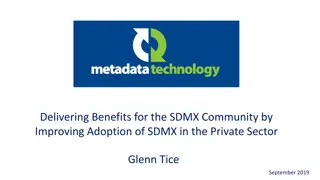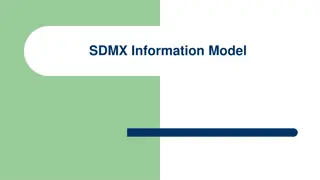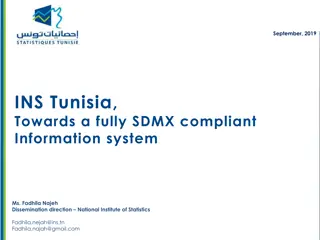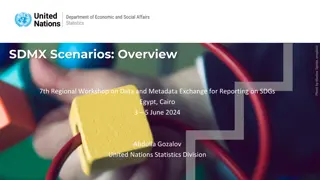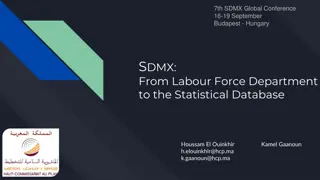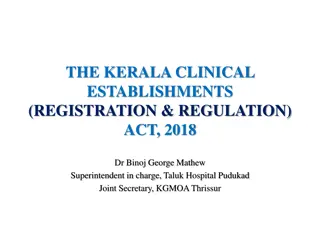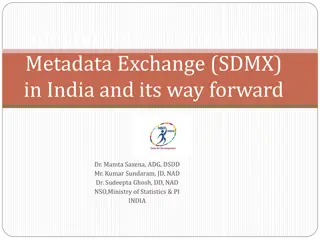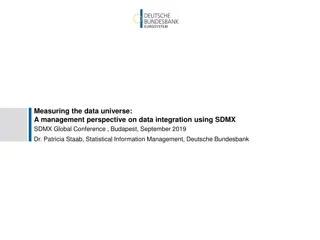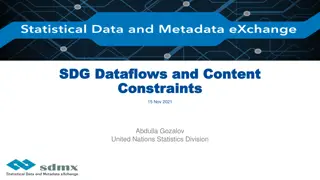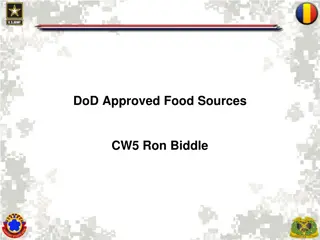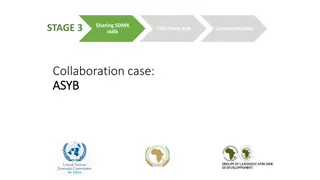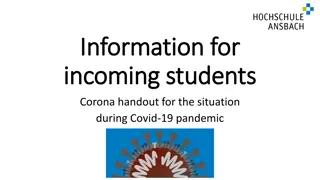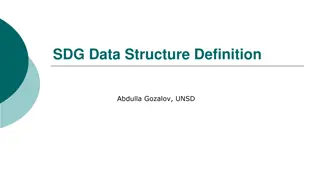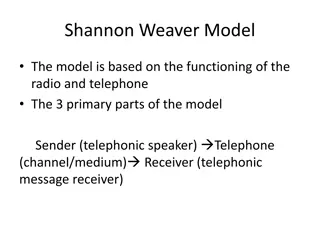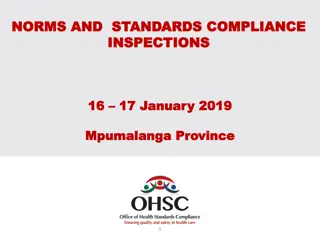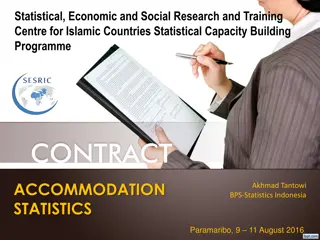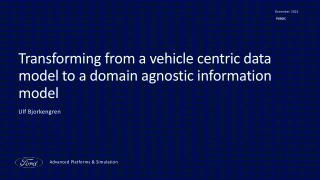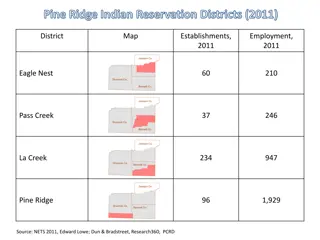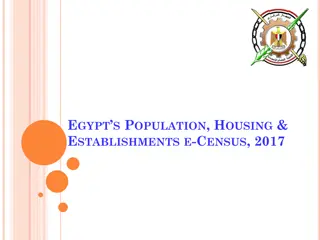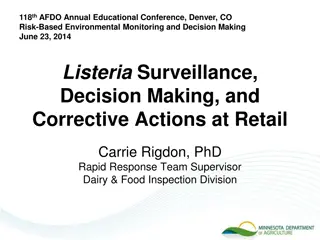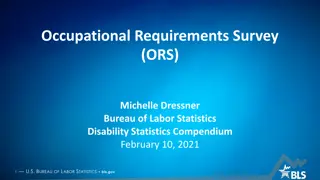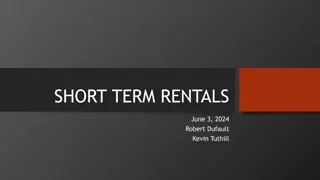Understanding the SDMX Information Model for Touristic Establishments
Explore the intricacies of the SDMX Information Model in the context of touristic establishments, delving into concepts like figures vs data and analyzing the number of touristic establishments. Dive into the UNSD-ESCWA Advanced SDMX Workshop held in Beirut from 27 Jun to 1 Jul 2022, presented by Abdulla Gozalov.
Download Presentation

Please find below an Image/Link to download the presentation.
The content on the website is provided AS IS for your information and personal use only. It may not be sold, licensed, or shared on other websites without obtaining consent from the author. Download presentation by click this link. If you encounter any issues during the download, it is possible that the publisher has removed the file from their server.
E N D
Presentation Transcript
Photo by Markus Spiske, unsplash SDMX Information Model Abdulla Gozalov UNSD-ESCWA Advanced SDMX Workshop Beirut, 27 Jun 1 Jul 2022
Figures vs data Number of touristic establishments Number of touristic establishments Number of touristic establishments Number Number of touristic establishments Number of touristic establishments Number of touristic establishments in Italy, annual data Italy Annual data Number of touristic establishments Tourism establishments in Italy, annual data in Italy, annual data in Italy, annual data in Italy, annual data in Italy, annual data in Italy, annual data Figures by themselves are meaningless. For data to be usable, it must be properly described. The descriptions let users know what the data actually represents. Indicator Indicator Indicator Indicator Indicator Indicator Indicator A100 A100 A100 A100 A100 A100 A100 B010 B010 B010 B010 B010 B010 B010 B020 B020 B020 B020 B020 B020 B020 Time Time Time Time Time Time Time Hotels and similar Hotels and similar Hotels and similar Hotels and similar Hotels and similar Hotels and similar Hotels and similar Tourist Campsites Tourist Campsites Tourist Campsites Tourist Campsites Tourist Campsites Tourist Campsites Tourist Campsites Holiday dwellings Holiday dwellings Holiday dwellings Holiday dwellings Holiday dwellings Holiday dwellings Holiday dwellings 2002A00 2002A00 2002A00 2002A00 2002A00 2002A00 2002A00 33411 33411 33411 33411 33411 33411 33411 2374 2374 2374 2374 2374 2374 2374 61479 61479 61479 61479 61479 61479 61479 2003A00 2003A00 2003A00 2003A00 2003A00 2003A00 2003A00 33480 33480 33480 33480 33480 33480 33480 2530 2530 2530 2530 2530 2530 2530 58526 58526 58526 58526 58526 58526 58526 2529 2529 2529 2529 2529 2529 2529 2529 2004A00 2004A00 2004A00 2004A00 2004A00 2004A00 2004A00 33518 33518 33518 33518 33518 33518 33518 56586 56586 56586 56586 56586 56586 56586 2005A00 2005A00 2005A00 2005A00 2005A00 2005A00 2005A00 33527 33527 33527 33527 33527 33527 33527 2411 2411 2411 2411 2411 2411 2411 68385 68385 68385 68385 68385 68385 68385 2006A00 2006A00 2006A00 2006A00 2006A00 2006A00 2006A00 33768 33768 33768 33768 33768 33768 33768 2510 2510 2510 2510 2510 2510 2510 68376 68376 68376 68376 68376 68376 68376 2007A00 2007A00 2007A00 2007A00 2007A00 2007A00 2007A00 34058 34058 34058 34058 34058 34058 34058 2587 2587 2587 2587 2587 2587 2587 61810 61810 61810 61810 61810 61810 61810 2
Developing a Data Model for Data Exchange Data model is developed to provide descriptions for all relevant characteristics of the data to be exchanged In some aspects similar to developing a relational database In SDMX, data model is represented by a Data Structure Definition (DSD). The shape of SDMX DSD is roughly similar to star schema. To design a DSD, we first need to find concepts that identify and describe our data. Statistics Division 3
Concept Unit of thought created by a unique combination of characteristics * Each concept describes something about the data. Concepts should express all relevant data characteristics. * Source: SDMX Glossary Statistics Division 4
Identifying Concepts Indicator Time Period Ref. Area Unit Multiplier Obs. Value Statistics Division 5
SDMX Concept Scheme Set of Concepts that are used in a Data Structure Definition or Metadata Structure Definition. * Concept scheme places concepts into a maintainable unit. Concept name Concept ID Indicator INDICATOR Reference area REF_AREA Time period TIME_PERIOD Unit multiplier UNIT_MULT Observation value OBS_VALUE * Source: SDMX Glossary Statistics Division 6
Dimension Which of the concepts are used to identify an observation? Indicator Reference area Time Period When all 3 are known, we can unambiguously locate an observation in the table. These are called dimensions. A dimension is similar in meaning to a database table s primary key field. Statistics Division 7
Attribute In our example, Unit Multiplier represents additional information about observations. This concept is not used to identify a series or observation. Such concepts are called attributes. Not to be confused with XML attributes! Similar to a database table s non-primary key fields. Statistics Division 8
Primary Measure Observation Value represents a concept that describes the actual values being transmitted. In SDMX, such a concept is called Primary Measure. Primary Measure is usually represented by concept with ID OBS_VALUE. Statistics Division 9
Dimension or Attribute? Choosing the role of a concept has profound implications on the structure of data. Concepts that identify data, should be made dimensions. Concepts that provide additional information about data, should be made attributes. If a concept is a dimension, it is possible to have time series that are different only in the value of this concept. E.g. if Unit of Measure is a dimension, it is possible to have separate time series for T and T/HA or, more controversially, KG and T Statistics Division 10
Dimension or Attribute? (2) Cambodia Fixed and Mobile telephone subscriptions 2013 20.6 million Fixed and Mobile telephone subscriptions 2012 19.7 million Fixed and Mobile telephone subscriptions 2013 140.9 per 100 pop. Unit of measure as a dimension (dimensions underlined) Ref.Area Indicator Time Period Unit Unit Mult. Obs. Value Cambodia Fixed and Mobile telephone subscriptions 2013 Number Millions 20.6 Cambodia Fixed and Mobile telephone subscriptions 2012 Number Millions 19.7 Cambodia Fixed and Mobile telephone subscriptions 2013 Per 100 pop. Units 140.9 Statistics Division 11
Dimension or Attribute? (3) Unit of measure as an attribute Violation! Ref.Area Indicator Time Period Unit Unit Mult. Obs. Value Cambodia Fixed and Mobile telephone subscriptions 2013 Number Millions 20.6 Cambodia Fixed and Mobile telephone subscriptions 2012 Number Millions 19.7 Cambodia Fixed and Mobile telephone subscriptions 2013 Per 100 pop. Units 140.9 The dataset above is invalid: duplicate observation The two values above are only different in their attributes Statistics Division 12
Dimension or Attribute? (4) Unit of measure as an attribute Ref.Area Indicator Time Period Unit Unit Mult. Obs. Value Cambodia Fixed and Mobile telephone subscriptions 2013 Number Millions 20.6 Cambodia Fixed and Mobile telephone subscriptions 2012 Number Millions 19.7 Cambodia Fixed and Mobile telephone subscriptions per 100 population 2013 Per 100 pop. Units 140.9 Now there is no violation because every row has a unique key The Unit concept is still useful Statistics Division 13
Attribute attachment In SDMX 2.0, attributes can be attached at observation, time series, group, or dataset level. In SDMX 2.1, attributes can be attached at observation, dimension(s), group, or dataset. When an attribute is attached to all dimensions except time, it is effectively attached to time series For practical purposes attributes are often attached at observation or time series. In addition, attributes can be designated as mandatory or conditional (optional). Mandatory attributes must be present at their attachment level for the dataset to be valid, while conditional attributes may be skipped. Dimensions, by contrast, must always be provided. Statistics Division 14
Cross-domain Concepts SDMX Statistical Working Group (SWG) develops and publishes Cross-Domain Concepts These are recommended concept IDs that are shared among statistical subject- matter domains and can be reused in many DSDs. The full list of cross-domain concepts is available at the SDMX web site under Guidelines: https://sdmx.org/?page_id=3215 The cross-domain concept scheme is also published at the SDMX Global Registry: https://registry.sdmx.org Statistics Division 15
Cross-domain Concepts: examples Some of the widely used cross-domain concepts include: Statistical indicator: INDICATOR Reference area: REF_AREA Sex: SEX Age: AGE Unit of measure: UNIT_MEASURE Unit multiplier: UNIT_MULT Time period: TIME_PERIOD Observation value: OBS_VALUE Statistics Division 16
Data model so far... Concept ID Role Attachment Indicator INDICATOR Dimension Reference area REF_AREA Dimension Time period TIME_PERIOD Dimension Unit multiplier UNIT_MULT Attribute Time series Observation value OBS_VALUE P.Measure Statistics Division 17
Representation DSD defines a range of valid values for each concept. When data are transferred, each of its descriptor concepts must have valid values. A concept can be Coded Un-coded with format Un-coded free text Statistics Division 18
Code A language-independent set of letters, numbers or symbols that represent a concept whose meaning is described in a natural language. A sequence of characters that can be associated with descriptions in any number of languages. Descriptions can be updated without disrupting mappings or other components of data exchange. Statistics Division 19
Code List A predefined list from which some statistical coded concepts take their values. A code list is a collection of codes maintained as a unit. A code list enumerates all possible values for a concept or set of concepts Sex code list Country code list Indicator code list, etc Statistics Division 20
Code List: Some Examples CL_SERIES CL_AREA CL_EDUCATION_LEV Statistics Division 21
SDMX Concepts and Code lists Code lists provide a representation for concepts, in terms of Codes. Codes are language-independent and may include descriptions in multiple languages. Code lists must be harmonized among all data providers that will be involved in exchange. Statistics Division 22
Un-coded Concepts Can be free-text: Any valid text can be used as a value for the concept. Footnote Can have their format specified Postal code: 5 digits Last update: date/time Statistics Division 23
Representation of concepts in SDMX Dimensions must be either coded or have their format specified. Free text is not allowed. Attributes can be coded or un-coded; format may optionally be specified. Statistics Division 24
Data model so far Concept ID Role Attachment Representation Indicator INDICATOR Dimension CL_INDICATOR Reference area REF_AREA Dimension CL_AREA Time period TIME_PERIOD Dimension Date/time (YYYY) Unit multiplier UNIT_MULT Attribute Time series CL_UNIT_MULT Observation value OBS_VALUE Pr. Measure Floating point number Statistics Division 25
Cross-domain Code Lists Similar to cross-domain concepts, SDMX Statistical Working Group (SWG) develops and publishes Cross-Domain Code Lists. When available, these are based on existing statistical classifications and contain codes from those classifications. Otherwise, codes are developed by the SWG. These codes should be used whenever possible in SDMX exchange or dissemination. The code lists are often extended with country or organization-specific codes. For example, the global Reference Area code list is often extended with subnational reference area codes for national data dissemination. Statistics Division 26
Cross-domain Concepts and Code Lists: examples Reference area: REF_AREA CL_AREA Sex: SEX CL_SEX Unit multiplier: UNIT_MULT CL_UNIT_MULT Statistics Division 27
Generic cross-domain codes Recommended Code Value Recommended Code Description _L Local extension (can be used as a prefix) _N Non response _O Other _S Subtotal _T Total _U No data/unknown _X Not allocated/unspecified _Z Not applicable These codes are recommended to be used in all code lists as appropriate. * Source: Guidelines for the creation and Management of SDMX Code Lists Statistics Division 28
Data model so far: Code Lists CL_INDICATOR Code Name CL_AREA (partial) POP Total Mid-Year Population Code Name AF Afghanistan CL_UNIT_MULT AL Albania Code Name AQ Antarctica 0 Units DZ Algeria 1 Tens AS American Samoa 2 Hundreds AD Andorra 3 Thousands 6 Millions 9 Billions Statistics Division 29
Data Structure Definition: summary Reference Reference Code lists Concept Scheme DSD Concept Concept ID Role Attachment Representation Code list ID Indicator INDICATOR Dimension Code List CL_INDICATOR Reference area REF_AREA Dimension Code List CL_AREA Time period TIME_PERIOD Dimension YYYY Unit multiplier UNIT_MULT Attribute Time series Code List CL_UNIT_MULT Obs. value OBS_VALUE Pr. Measure Floating point number Statistics Division 30
Importance of Data Model Data model, represented by DSD, defines what data can be encoded and transmitted. Flaws in a DSD may have significant adverse impact on data exchange Missing concepts Incorrect role of concepts Un-optimized model Statistics Division 31
Dataset Organised collection of data defined by a Data Structure Definition (DSD)* A dataset is structured in accordance with one DSD Serves as a container for time-series or cross-sectional series in SDMX data messages. Statistics Division 32 *Source: SDMX Glossary
Time Series A set of observations of a particular variable, taken at different points in time. Observations that belong to the same time series, differ in their time dimension. All other dimension values are identical. Observation-level attributes may differ across observations of the same time series. Statistics Division 33
Time Series: Demonstration Statistics Division
Non-Time Series Data (a.k.a. Cross-Sectional Data1) A non-time dimension(s) is chosen along which a set of observations is constructed. E.g. for a survey or census the time is usually fixed and another dimension may be chosen to be reported at the observation level Used less frequently than time series representation Statistics Division 1 The term "Cross-sectional" was discontinued in SDMX 2.1 35
Time Series View vs Cross-Sectional View The Sex dimension was chosen as the cross-sectional measure. Note that Time is still applicable. 36 Statistics Division
Keys in SDMX Series key uniquely identifies a series In the case of time series, consists of all dimensions except time Group key uniquely identifies a group of time series Consists of a subset of the series key Statistics Division 37
Structural and Reference Metadata Structural Metadata: Identifiers and Descriptors, e.g. What we have covered so far Data Structure Definition Concept Scheme Code Reference Metadata: Describes contents and quality of data, e.g. Indicator definition Comments and limitations Statistics Division 38
Reference Metadata in SDMX Can be stored or exchanged separately from the object it describes, but be linked to it Can be indexed and searched Reported according to a defined structure Statistics Division 39
Metadata Structure Definition (MSD) MSD Defines: The object type to which reference metadata can be associated E.g. DSD, Dataflow. The components comprising the object identifier of the target object E.g. the draft SDG MSD allows metadata to be attached a partial key. Concepts used to express metadata ( metadata attributes ). E.g. Indicator Definition, Quality Management Statistics Division 40
Reference metadata in SDMX 3.0 Reference metadata support will be redesigned in SDMX 3.0. To simplify implementation, discovery, and use It will be possible to declare reference metadata concepts directly in the DSD, and transmit reference metadata as part of a dataset or in a separate message. Metadata Structure Definitions, metadata sets, and metadata flows will still be supported for higher-level metadata that is not attached to specific datasets. It is expected that simplification of reference metadata will lead to its implementation in common tools as well as much broader usage. Statistics Division 41
Dataflow and Metadataflow Dataflow defines a view on a Data Structure Definition Can be constrained to a subset of codes in any dimension Can be categorized, i.e. can have categories attached In its simplest form defines any data valid according to a DSD Similarly, Metadataflow defines a view on a Metadata Structure Definition. Statistics Division 42
Content Constraints Constraints can be used to define which codes or combinations of codes are allowed (or disallowed) Constraints can define more granular validation rules than a simple validation of codes Are often attached to the Dataflow but can also be attached to DSD, Provision Agreement, etc Statistics Division 43
Content Constraint Types Cube Region Constraints define valid (or invalid) codes as a subset of those defined in a DSD s code lists. E.g. for the Country Global SDG Dataflow, the only valid value for dimension REPORTING_TYPE is N ( National ). Series Constraints define valid (or invalid) combinations of codes defined in a DSD s code lists. SERIES=SH_STA_STNT (Proportion of children moderately or severely stunted) AGE=Y0T4 (Under five years old) COMPOSITE_BREAKDOWN=_T,MS_MIGRANT,MS_NOMIGRANT,MS_EUMIGRANT, or MS_NONEUMIGRANT PRODUCT=_T ACTIVITY=_T Statistics Division 44
Category, Category Scheme, and Categorisation Category is a way of classifying data for reporting or dissemination Subject matter-domains are commonly implemented as Categories, such as Demographic Statistics , Economic Statistics Category Scheme groups Categories into a maintainable unit. Categorisation links a Category to the object to which it applies. Statistics Division 45
SDMX Messages Any SDMX-related information is exchanged in the form of documents called messages. An SDMX message can be sent in a number of standard formats including XML, JSON, CSV. There are several types of SDMX messages, each serving a particular purpose, e.g. Structure message is used to transmit structural information such as DSD, MSD, Concept Scheme, etc. GenericData, StructureSpecificData, and other messages are used to send data. SDMX messages in the XML format are referred to as SDMX-ML messages. 46 Statistics Division
SDMX Artefacts While there are many types of artefacts, in almost all situations SDMX Artefact refers to a maintainable and versionable component of structural metadata. Concept Scheme DSD Code List Note that e.g. an individual Code is not an artefact, since it can only exist and be transmitted as part of a Code List. Statistics Division 47
SDMX Artefact Identification and Versioning Identification of SDMX Artefact consists of 3 fields: ID; Maintenance Agency; Version Type Name ID Maintenance Agency Version DSD NA Main Aggregates NA_MAIN ESTAT 1.11 DSD NA Main Aggregates NA_MAIN ESTAT 1.10 Concept Scheme SDG Concept Scheme SDG_CONCEPTS IAEG-SDGs 1.0 Code List Reference area code list CL_AREA SDMX 2.0 Statistics Division 48
THANK YOU Statistics Division 49



